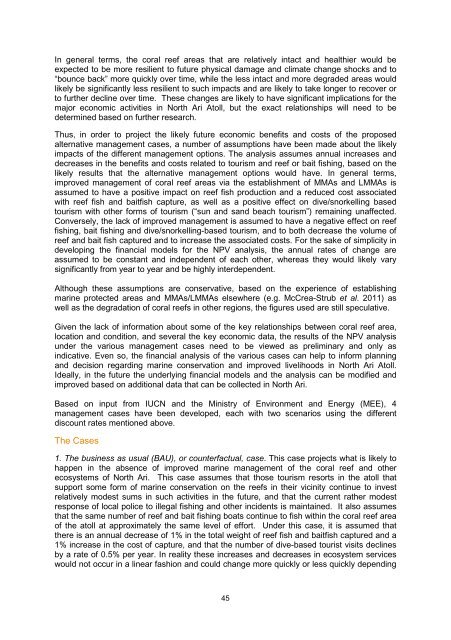Ecosystem Services Assessment of North Ari Atoll Maldives
2lV0IPE
2lV0IPE
You also want an ePaper? Increase the reach of your titles
YUMPU automatically turns print PDFs into web optimized ePapers that Google loves.
In general terms, the coral reef areas that are relatively intact and healthier would be<br />
expected to be more resilient to future physical damage and climate change shocks and to<br />
“bounce back” more quickly over time, while the less intact and more degraded areas would<br />
likely be significantly less resilient to such impacts and are likely to take longer to recover or<br />
to further decline over time. These changes are likely to have significant implications for the<br />
major economic activities in <strong>North</strong> <strong>Ari</strong> <strong>Atoll</strong>, but the exact relationships will need to be<br />
determined based on further research.<br />
Thus, in order to project the likely future economic benefits and costs <strong>of</strong> the proposed<br />
alternative management cases, a number <strong>of</strong> assumptions have been made about the likely<br />
impacts <strong>of</strong> the different management options. The analysis assumes annual increases and<br />
decreases in the benefits and costs related to tourism and reef or bait fishing, based on the<br />
likely results that the alternative management options would have. In general terms,<br />
improved management <strong>of</strong> coral reef areas via the establishment <strong>of</strong> MMAs and LMMAs is<br />
assumed to have a positive impact on reef fish production and a reduced cost associated<br />
with reef fish and baitfish capture, as well as a positive effect on dive/snorkelling based<br />
tourism with other forms <strong>of</strong> tourism (“sun and sand beach tourism”) remaining unaffected.<br />
Conversely, the lack <strong>of</strong> improved management is assumed to have a negative effect on reef<br />
fishing, bait fishing and dive/snorkelling-based tourism, and to both decrease the volume <strong>of</strong><br />
reef and bait fish captured and to increase the associated costs. For the sake <strong>of</strong> simplicity in<br />
developing the financial models for the NPV analysis, the annual rates <strong>of</strong> change are<br />
assumed to be constant and independent <strong>of</strong> each other, whereas they would likely vary<br />
significantly from year to year and be highly interdependent.<br />
Although these assumptions are conservative, based on the experience <strong>of</strong> establishing<br />
marine protected areas and MMAs/LMMAs elsewhere (e.g. McCrea-Strub et al. 2011) as<br />
well as the degradation <strong>of</strong> coral reefs in other regions, the figures used are still speculative.<br />
Given the lack <strong>of</strong> information about some <strong>of</strong> the key relationships between coral reef area,<br />
location and condition, and several the key economic data, the results <strong>of</strong> the NPV analysis<br />
under the various management cases need to be viewed as preliminary and only as<br />
indicative. Even so, the financial analysis <strong>of</strong> the various cases can help to inform planning<br />
and decision regarding marine conservation and improved livelihoods in <strong>North</strong> <strong>Ari</strong> <strong>Atoll</strong>.<br />
Ideally, in the future the underlying financial models and the analysis can be modified and<br />
improved based on additional data that can be collected in <strong>North</strong> <strong>Ari</strong>.<br />
Based on input from IUCN and the Ministry <strong>of</strong> Environment and Energy (MEE), 4<br />
management cases have been developed, each with two scenarios using the different<br />
discount rates mentioned above.<br />
The Cases<br />
1. The business as usual (BAU), or counterfactual, case. This case projects what is likely to<br />
happen in the absence <strong>of</strong> improved marine management <strong>of</strong> the coral reef and other<br />
ecosystems <strong>of</strong> <strong>North</strong> <strong>Ari</strong>. This case assumes that those tourism resorts in the atoll that<br />
support some form <strong>of</strong> marine conservation on the reefs in their vicinity continue to invest<br />
relatively modest sums in such activities in the future, and that the current rather modest<br />
response <strong>of</strong> local police to illegal fishing and other incidents is maintained. It also assumes<br />
that the same number <strong>of</strong> reef and bait fishing boats continue to fish within the coral reef area<br />
<strong>of</strong> the atoll at approximately the same level <strong>of</strong> effort. Under this case, it is assumed that<br />
there is an annual decrease <strong>of</strong> 1% in the total weight <strong>of</strong> reef fish and baitfish captured and a<br />
1% increase in the cost <strong>of</strong> capture, and that the number <strong>of</strong> dive-based tourist visits declines<br />
by a rate <strong>of</strong> 0.5% per year. In reality these increases and decreases in ecosystem services<br />
would not occur in a linear fashion and could change more quickly or less quickly depending<br />
45


